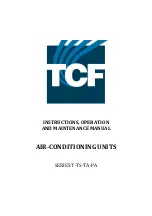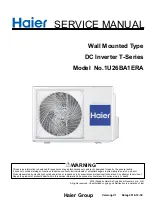
6
G
F
E
D
C
A
A
D
E
B
C
G
F
E
D
B
4. Installing the refrigerant piping
Fig. 4-3
P100-P140
A
Front piping cover
B
Piping cover
C
Stop valve
D
Service panel
E
Bend radius : 100 mm-150 mm
A
Stop valve <Liquid side>
B
Stop valve <Gas side>
C
Service port
D
Open/Close section
Fig. 4-4
Fig. 4-5
Fig. 4-6
C
H
A
I
E
B
(1)
(2)
4.3. Refrigerant piping (Fig. 4-3)
For P100-P140
Remove the service panel
D
(3 screws) and the front piping cover
A
(2 screws) and
rear piping cover
B
(2 screws).
1
Perform refrigerant piping connections for the indoor/outdoor unit when the out-
door unit’s stop valve is completely closed.
2
Vacuum-purge air from the indoor unit and the connection piping.
3
After connecting the refrigerant pipes, check the connected pipes and the indoor
unit for gas leaks. (Refer to 4.4 Refrigerant pipe airtight testing method)
4
A high-performance vacuum pump is used at the stop valve service port to main-
tain a vacuum for an adequate time (at least 1 hour after reaching –101 kPa (5
Torr)) in order to vacuum dry the inside of the pipes. Always check the degree of
vacuum at the gauge manifold. If there is any moisture left in the pipe, the degree
of vacuum is sometimes not reached with short-time vacuum application.
After vacuum drying, completely open the stop valves (both liquid and gas) for the
outdoor unit. This completely links the indoor and outdoor refrigerant circuits.
•
If the vacuum drying is inadequate, air and water vapor remain in the refriger-
ant circuits and can cause abnormal rise of high pressure, abnormal drop of
low pressure, deterioration of the refrigerant machine oil due to moisture, etc.
•
If the stop valves are left closed and the unit is operated, the compressor and
control valves will be damaged.
•
Use a leak detector or soapy water to check for gas leaks at the pipe connec-
tion sections of the outdoor unit.
•
Do not use the refrigerant from the unit to purge air from the refrigerant lines.
•
After the valve work is completed, tighten the valve caps to the correct torque:
20 to 25 N·m (200 to 250 kgf·cm).
Failure to replace and tighten the caps may result in refrigerant leakage. In
addition, do not damage the insides of the valve caps as they act as a seal to
prevent refrigerant leakage.
5
Use sealant to seal the ends of the thermal insulation around the pipe connection
sections to prevent water from entering the thermal insulation.
4.4. Refrigerant pipe airtight testing method
(1) Connect the testing tools.
•
Make sure the stop valves
A
B
are closed and do not open them.
•
Add pressure to the refrigerant lines through the service port
C
of the liquid
stop valve
A
.
(2) Do not add pressure to the speci
fi
ed pressure all at once; add pressure little by
little.
1
Pressurize to 0.5 MPa (5 kgf/cm²G), wait 5 minutes, and make sure the pres-
sure does not decrease.
2
Pressurize to 1.5 MPa (15 kgf/cm²G), wait 5 minutes, and make sure the pres-
sure does not decrease.
3
Pressurize to 4.15 MPa (41.5 kgf/cm²G) and measure the surrounding tem-
perature and refrigerant pressure.
(3) If the speci
fi
ed pressure holds for about one day and does not decrease, the pipes
have passed the test and there are no leaks.
•
If the surrounding temperature changes by 1 °C, the pressure will change by
about 0.03 MPa (0.3 kgf/cm²G). Make the necessary corrections.
(4) If the pressure decreases in steps (2) or (3), there is a gas leak. Look for the
source of the gas leak.
4.5. Stop valve opening method
The stop valve opening method varies according to the outdoor unit model. Use the
appropriate method to open the stop valves.
(1) Gas side of P100-P140 (Fig. 4-5)
1
Remove the cap and turn the valve rod counterclockwise as far as it will go with
the use of a 5 mm hexagonal wrench. Stop turning when it hits the stopper.
(ø 15.88: Approximately 13 revolutions)
2
Make sure that the stop valve is open completely and rotate the cap back to its
original position.
(2) Liquid side of P100-P140 (Fig. 4-6)
1
Remove the cap and turn the valve rod counterclockwise as far as it will go with
the use of a 4 mm hexagonal wrench. Stop turning when it hits the stopper.
(ø9.52: Approximately 10 revolutions)
2
Make sure that the stop valve is open completely and rotate the cap back to its
original position.
Refrigerant pipes are protectively wrapped for P100-P140
•
The pipes can be protectively wrapped up to a diameter of ø90 before or after
connecting the pipes. Cut out the knockout in the pipe cover following the groove
and wrap the pipes.
Pipe inlet gap for P100-P140
•
Use putty or sealant to seal the pipe inlet around the pipes so that no gaps remain.
(If the gaps are not closed, noise may be emitted or water and dust will enter the
unit and breakdown may result.)
H
Double spanner section
(Do not apply a spanner other than to this section. Doing
so would cause coolant leaks.)
I
Seal section
(Seal the end of the heat insulation material at the pipe
connection section with whatever seal material you have
on hand so that water does not in
fi
ltrate the heat insula-
tion material.)
A
Valve
B
Unit side
C
Cap
D
Local pipe side
E
Pipe cover
F
Service port
G
Wrench hole
H
D
E
G
F
A
G
I
D
C
B
Precautions when using the charge valve (Fig. 4-7)
Do not tighten the service port too much when installing it, otherwise, the valve core
could be deformed and become loose, causing a gas leak.
After positioning section
B
in the desired direction, turn section
A
only and tighten it.
Do not further tighten sections
A
and
B
together after tightening section
A
.
Warning:
When installing the unit, securely connect the refrigerant pipes before starting
the compressor
.
* The
fi
gure to the left is an example only.
The stop valve shape, service port position,
etc., may vary according to the model.
* Turn section
A
only.
(Do not further tighten sections
A
and
B
together.)
C
Charge hose
D
Service port
A
B
C
D
Fig. 4-7
E
Local pipe
F
Sealed, same way for gas side
G
Pipe cover







































